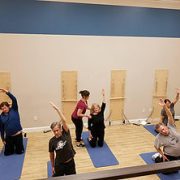Vertigo and Fall Risk: 5 Ways to Safeguard Yourself Against Unexpected Falls
Vertigo is often described as a distressing sensation of spinning that makes you feel as if the world is moving around you – or that you are spinning yourself. It’s an unsettling experience – and can be dangerous – as it puts you at a greater risk for falling. Over 3 million older adults are treated in the emergency room every year due to fall-related injuries. One out of five of those falls causes serious injury – like a broken bone or head trauma.
If you are suffering from vertigo, it’s critical that you take time and due diligence to get to the bottom of what’s causing it so that you can safeguard yourself against unexpected falls. The good news is this is entirely possible. But first, it’s important for you to know that vertigo is a symptom, and not a diagnosis. Vertigo is the result of a disturbance in your inner ear (vestibular system). It can be caused by various things, namely, Meniere’s disease, benign paroxysmal positional vertigo (BPPV), vestibular neuritis, and cervicogenic dizziness… just to name a few. Once you’ve identified the root cause of your vertigo – the correct treatment approach is possible. I can’t tell you how many horror stories I’ve heard from people suffering from vertigo longer than they needed to – all because they didn’t get the right tests to diagnose the cause – or were prescribed medication they didn’t actually need. All the while, continuing to live with a constant fear of falling and never knowing when their next vertigo attack would occur.
The reason suffering from vertigo puts you at such risk for falling is because when it comes to balance, we rely on three bodily systems. One is your vestibular system, which vertigo disrupts. The other two systems are your vision and proprioception. All three systems are responsible for helping you orient and visualize yourself in space. When you have vertigo – you’re forced to rely on (and train) the other two.
The good news is there are strategies you can employ to compensate for a mal-functioning vestibular system.
If you suffer from vertigo – here are five simple and effective strategies that can help minimize your fall risk and enhance your safety:
-
Remove Hazards: Roll Up and Stow Away Rugs
In a home environment, even seemingly harmless elements like rugs can pose a significant risk. Rolling up and storing rugs minimizes the chance of tripping or slipping, providing a safer space to move around, especially during vertigo episodes. Smooth, obstacle-free floors reduce the likelihood of unexpected falls and help maintain stability.
-
Illuminate Pathways: Install Night Lights for Nighttime Mobility
Navigating through the house at night, especially when experiencing vertigo, can be daunting. Installing night lights along hallways, staircases, and near the bathroom provides essential visibility and helps prevent accidental falls. With well-lit pathways, you can confidently move around during the night, reducing the risk of missteps or collisions with objects.
-
Exercise Caution: Walk with a Companion and Use Hiking Poles
Engaging in physical activity is crucial for maintaining health, but doing so alone when experiencing vertigo can be risky. Pairing up with a friend for walks provides both companionship and an added layer of safety. Additionally, using hiking poles offers stability and support, especially when dizziness strikes unexpectedly, allowing for more secure movement during outdoor activities.
-
Focus and Reorient: Lock Your Gaze on a Steady Object during Dizziness
During vertigo episodes, it’s common to feel disoriented and unsteady. A practical technique to regain stability is to lock your gaze on a stable and fixed object. This method helps recenter your focus and gradually reduces the sensation of spinning or imbalance, allowing you to regain control of your body and surroundings.
-
Safe Driving Practices: Stabilize Focus and Minimize Distractions
When vertigo strikes while driving, it’s essential to prioritize safety. If feeling dizzy behind the wheel, fixate your gaze on a stationary object—such as the dashboard or the road ahead—to regain a sense of stability. Additionally, reduce all distractions by turning off the radio and refraining from engaging in conversations with passengers. Prioritizing focus and minimizing external stimuli can help mitigate the risks associated with vertigo while driving.
While these strategies can be helpful – please know that you don’t have to let vertigo keep running your life and stop you from doing what you love. With proper treatment, you can stay out of the hospital, stop taking medication and move out of the fall risk category with the support of a good vestibular specialist. Diagnosing vertigo is a step-by-step process that starts with a detailed medical history and extends to various physical examinations. Vestibular specialists will employ a range of tests, including specialized balance assessments for fall risk, to pinpoint your exact cause of vertigo. Navigating through these diagnostic tools is crucial for developing a treatment plan that works. Once the correct diagnosis is made, treatment can begin immediately to start retraining your brain. The key is to train your brain to stop relying on the damaged part of the inner ear (that leads to vertigo and dizziness) – and help it to rely on your other two balance systems instead so that you can stay safe and improve your balance.
Interested in learning more about Vertigo?
Join us for our Free Online Masterclass for Vertigo Sufferers! It’s happening January 23rd, from 6-7pm via zoom – click here to reserve your seat before they’re all out.
Dr. Carrie Jose, Physical Therapist and Pilates expert, owns CJ Physical Therapy & Pilates in Portsmouth and writes for Seacoast Media Group. To get in touch, or seat in her upcoming Masterclass for Vertigo Sufferers – visit www.cjphysicaltherapy.com – or call 603-380-7902










